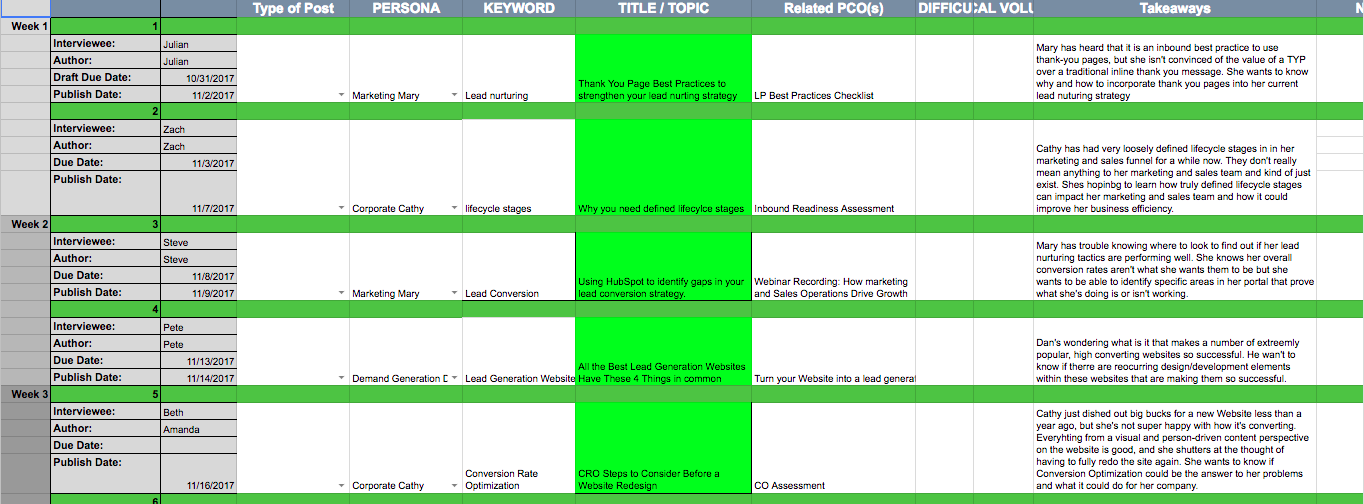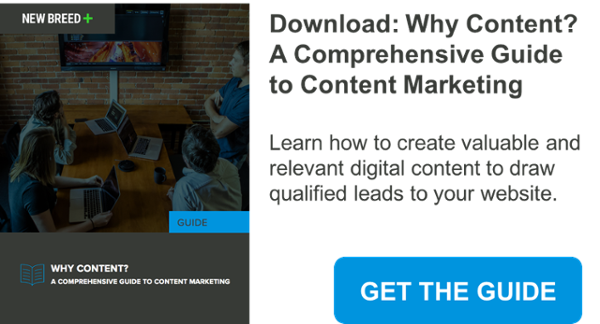In this eight-step guide, we'll share our secret formula for creating content gold.
1. Solidify your Buyer Personas
Your ability to create an effective content strategy is contingent on how well you know your audience. There's no substitute or shortcut for assessing whether your buyer personas accurately represent your ideal customer. But you can rest assured that any time you invest in identifying and documenting your personas' core needs, challenges, pain points and demographics will be rewarded down the line. Even if revisiting your buyer personas means taking a step back before pushing forward on new initiatives, doing so will directly impact your marketing performance and ability to drive consistent revenue growth.
2. Conduct a Content Audit to Identify Funnel Gaps
Before you can begin formulating a content strategy, it's important to take inventory of your existing assets. Comb through previously published blog posts, e-books, templates and any additional resources and identify what funnel stage (ToFu, MoFu or BoFu) each asset maps to. Doing so will help you recognize conversion pathway gaps and allow you to focus your content efforts moving forward. If you find you have a plethora of ToFu and BoFu resources but no MoFu content, you're likely experiencing churn in the middle of your funnel because prospects lack relevant resources and engagement opportunities.
Next, identify the buyer persona targeted by each asset. Part of evaluating and optimizing your content strategy means knowing when to cut the cord and eliminate content that isn't attracting a qualified viewership. If a piece is generating page views but doesn't resonate with your target personas, it's not likely that those visitors are converting into paying customers. Attracting the wrong audience may get you short-term traffic, but it won't help you grow and see a return on your marketing investment. As you track existing content to individual buyer personas, consider the function that each asset is meant to fill and whether it's structured to achieve that end.
While you create an inventory of your content assets, pull key data on each piece of content to help inform your conclusions. Metrics like page views, click-through rate and conversion rate will have more practical significance if you can connect them to the strategic elements mentioned above. If a blog post has a high number of page views but a dismal conversion rate, check whether the content is persona-driven and aligned to the correct funnel stage to determine the best optimization approach to take.
As you're conducting a content audit, enlist your SEO strategist to do an SEO audit of your existing content and landing pages to help guide editorial calendar creation.
3. Create an Editorial Calendar

Use the gaps you identified in your content audit to inform the topics you choose and the form they'll take. At this step, enlist the help of your SEO strategist to make sure all new content is framed and worded to drive search engine rankings and improve your relevance score. An SEO audit should have revealed any keyword gaps in your strategy and helped you identify click behavior and search intent — two things which can help you curate more relevant and helpful content to drive traffic.
An editorial calendar should include all your proposed content topics, titles, associated keyword(s), target personas, funnel stages, relevant offers and possible subject matter experts to be interviewed. Focus on addressing key content gaps before optimizing or re-writing content that's already performing at a reasonable level.
4. Conduct Interviews with Subject Matter Experts
Not everyone at your company will be a compelling and effective writer. Nor will they have the time to devote to drafting a piece of content. Identifying SMEs in your organization will help your copywriters quickly get up to speed on subjects outside of their wheelhouse (so they can write with the authority of an expert while maintaining journalistic concision) and allow your SMEs to be heard without having to write copy.
Interviews with SMEs shouldn't exceed thirty minutes and should give your copywriter all the resources and context necessary to deliver on the proposed topic and length. The more your content team works with specific SMEs, the more productive and fruitful their relationship should become. Your copywriter can use previous interviews with SMEs to help identify additional topics to address and hone the sophistication of their communication over time.
5. Create a Draft
At this stage, your content marketer should have everything they need to guide their first draft. Being an effective marketing copywriter means mastering the art of inception. In addition to writing well, writers should be able to operate with a number of characteristics and layers in mind. Of course, they must address the intended topic and takeaway. But they should also tailor their tone, focus and structure to align with the intended persona's pain points within the context of a specific buyer's journey stage. What's more, they should use keyword and intent research to guide their diction choices and topic scope. No piece of content should exist in a vacuum, so it's critical to keep related assets and CTAs in mind and write with the intention of connecting those dots, too.
6. Collaborate on Edits
No matter how dynamite your copywriter is, every draft needs a second pair of eyes. In addition to lending another perspective, having an editor will help you combat typo or error blindness — a common psychological phenomenon that describes why it's so difficult to catch your own typos. When we read our own work, our brain is preoccupied with the meaning we want to convey (an evolutionary function that helps us translate letters into words and narratives within the space of an instant) and our intention overrides our ability to accurately see what's in front of us.
Formalizing your editing process will also give you the opportunity to confirm that your end product checks all the boxes it was intended to. Furthermore, pulling SMEs into the final editing stage is a good way to ensure that a topic was translated and represented as intended without monopolizing an SME's time.
7. Optimize Content for Superlative Engagement
Every piece of content you create should be keyword optimized and include relevant inbound links and CTAs. Consult your SEO strategist to help formulate a linking strategy that maps to key pillar pages on your site and supports the development of coherent topic clusters. When choosing CTAs, relevance is crucial. Make sure that your associated offer aligns with the original target persona and funnel stage to increase the likelihood of conversions.
Your content should also look appealing. That means adding feature images and spacing the text in a way that promotes quick and easy content consumption. Numbered lists are a preferred digital medium because they highlight key takeaways and allow readers to navigate freely while maintaining their sense of place within an article. That said, lists aren't the perfect format for all topics. Remember to marry form and function to support greater reader comprehension.
8. Track Your Content's Performance and Optimize as you Go
The crux of inbound marketing is the transparency it enables. With all leads being funneled through your website, you'll have access to all the data insight you need to inform and focus your content marketing strategy. Once you publish a piece of content, track its performance and use engagement metrics as journey markers on the path of continuous improvement.
To learn more about how implementing a content marketing strategy will affect your bottom line, download our Why Content? guide below.





